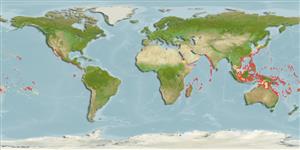>
Anguilliformes (Eels and morays) >
Ophichthidae (Snake eels) > Ophichthinae
Etymology: Brachysomophis: Greek, brachys, eia = short + Greek, soma = body + Greek, ophis = serpent (Ref. 45335); henshawi: Named for Henry W. Henshaw..
More on authors: Jordan & Snyder.
Environment: milieu / climate zone / depth range / distribution range
Ekologi
laut berasosiasi dengan karang; kisaran kedalaman 1 - 35 m (Ref. 42180). Tropical
Indo-Pacific.
Size / Weight / umur
Maturity: Lm ? range ? - ? cm
Max length : 120 cm TL jantan/; (Ref. 89972)
deskripsi pendek
Morfologi | Morfometrik
vertebrata, bertulang belakang: 128 - 134. With tail 45-48% and head 13-16% of TL; dorsal fin arising well behind pectoral tips; pectoral fins fan-shaped, not elongate; snout short, about 3.4 in jaw; jaws elongate, about 2.3-3 in head; nostrils in short tubes in upper lip and closely associated; cirri of labial fringe unbranched, short and stubby; flesh above and behind eye laterally elevated as a ridge; dorsal head profile depressed and constricted behind eyes, the flesh forming a lateral eave behind dorsal margin of eye; head pores and lateral-line pores apparent; free sensory neuromasts visible as rows of white spots on nape; teeth conical; coloration in life variable; fins pale except dorsal notably dark basally with a pale margin; lateral-line pores in distinct dark spots; numerous dark spots above lateral line on body (Ref. 42180).
Found over sandy areas, usually near or within coral or rocky reefs (Ref. 42180, 75154). Feeds on fishes and crtustaceans (Ref. 89972). Benthic (Ref. 58302, 75154). At night, it is usually encountered with its head and even the anterior portion of its body protruding from the substrate at night (Ref. 42180). At day time, it often remains buried with only the tip of its snout and the top of its head projecting from the sand or mud (Ref. 42180).
Life cycle and mating behavior
Kematangan | Reproduksi, perkembang biakan | Pemijahan | telur-telur | Fecundity | Larva
McCosker, J.E. and J.E. Randall, 2001. Revision of the snake-eel genus Brachysomophis (Anguilliformes: Ophichthidae), with description of two new species and comments on the species of Mystriophis. Indo-Pac. Fish. (33):1-32. (Ref. 42180)
Status IUCN Red List (Ref. 130435)
ancaman kepada manusia
Harmless
penggunaan manusia
informasi lanjut
Nama-nama umumSinonim (persamaan)metabolismePemangsaEkotoksikologiReproduksi, perkembang biakanKematanganPemijahanSpawning aggregationFecunditytelur-telurpekembangan telor
Umur / SaizPertumbuhanpanjang-beratpanjang-panjangukuran frekuensiMorfometrikMorfologiLarvaDinamika larvapemulihanKelimpahanBRUVS
AcuanBudidaya airprofil budidaya airStrainGenetikaElectrophoresesDiturunkanPenyakit-penyakitPengolahanNutrientsMass conversion
mitraGambarStamps, Coins Misc.Suara-suaraCiguateraKecepatanTipe renangArea insangOtolithsOtakPenglihatan / visi
Alat, peralatan
laporan khas
muat turun XML
Sumber internet
Estimates based on models
Preferred temperature (Ref.
123201): 24.6 - 29.3, mean 28 °C (based on 2349 cells).
Phylogenetic diversity index (Ref.
82804): PD
50 = 0.5078 [Uniqueness, from 0.5 = low to 2.0 = high].
Bayesian length-weight: a=0.00089 (0.00039 - 0.00204), b=3.00 (2.80 - 3.20), in cm total length, based on LWR estimates for this (Sub)family-body shape (Ref.
93245).
Trophic level (Ref.
69278): 4.0 ±0.6 se; based on size and trophs of closest relatives
Daya lenting (Ref.
120179): sedang, Waktu penggandaan populasi minimum 1.4 - 4.4 tahun (Preliminary K or Fecundity.).
Fishing Vulnerability (Ref.
59153): High to very high vulnerability (72 of 100).
